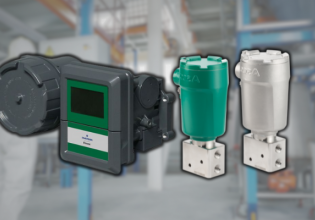Examples of Machine and Human-readable Data in Industrial Fluid Dynamics
How can engineers analyze human- and machine-readable data in several industrial applications, such as thermal management and HVAC systems?
Fluid Dynamics
Liquid and gases are fluids, meaning they do not have a fixed shape and take acting force. They respond to shear stress and cannot withstand or resist the shear stress; even minor shear stress affects the fluid flow. As long as the shear stress is applied, the liquid element continues to deform.
Fluids are an essential aspect of biological life. The most crucial phenomenon when studying fluids is the continuum hypothesis. In continuum fluid studies, the fluid is modeled as a single entity rather than a compound consisting of billions of molecules or atoms.
Fluid dynamics is the branch of fluid mechanics dealing with fluid motion. It analyzes different properties and behavior of fluids in motion states under various natural and physical phenomena. It also examines how it comes in contact with and affects the properties of physical objects. Additionally, it analyzes how physical things affect the different properties of fluid flow.
Another branch of fluid mechanics is fluid statics, which is concerned with the fluids at rest and their underlying properties.
Industries Using Fluid Dynamics
Studying and evaluating fluids can lead to innovations in science, engineering, and related industries. For example, fluids play an essential role in hydroelectric electric power generation, oil and gas transfer pipelines, and structure analysis such as buildings, dams, and bridges. They can be used in internal combustion systems of the transport system and engines in aerospace propulsion systems.

Figure 1. The Tahoma Dam.
Computational Fluid Dynamics (CFD)
Computational fluid dynamics (CFD) is an analysis tool for fluid dynamics in industrial applications. It uses different numerical and digital algorithms to study fluid, how it affects other physical objects, and how the other things affect the fluid flow and properties. These software tools run on a computer to analyze the fluid flow and observe its changing characteristics. CFD can model interacting physical properties not possible in a real-world scenario.
Industries Using Computational Fluid Dynamics (CFD)
Some common industrial CFD applications include HVAC, aerodynamics, thermal management, structures, and hydrodynamics.
HVAC Industry
CFD is used in the HVAC industry to study airflow properties. Proper HVAC system design is crucial to achieving desired environmental parameters. Accurate equipment design also prevents under-designing or above-designing, avoiding resource wastage.
CFD can analyze ventilation systems for HVAC, such as passive and displacement ventilation. It observes airflow patterns, velocities, pressure profiles, and thermal mapping of an area due to airflow. The CFD readings are then used to design airflow components such as air blowers, centrifugal fans, and area ventilation systems.
Aerodynamics
Aerodynamics studies how airflow affects objects and how objects move in the air. Studying aerodynamics helps design body parts that offer less resistance during motion and less fuel and energy consumption.

Figure 2. An example of CFD in aerodynamics. Image used courtesy of University of Alabama at Birmingham
CFD is involved in every aspect of aerodynamics analysis and development. It is used in aerospace to calculate lift, drag, and other design factors that help increase efficiency, and reduce emissions and environmental noise. In the automotive industry, CFD simulates different automotive vehicles and studies various design factors. In HVAC piping, CFD can calculate pressure loss, especially at the bending and corners.
Thermal Management
Thermal management studies heat flows inside an area and in between different objects. This is crucial in temperature-sensitive areas, such as drug manufacturing, to provide optimum temperature with less costly resources and prevent heat loss.
CFD tools simulate air flows inside an area and predict thermal management by analyzing solid objects in a room. It identifies possible hot spots due to inadequate airflow. CFD allows optimizing the airflow inside an area for proper heat distribution throughout.

Figure 3. Thermal imaging for pipeline inspection.
CFD can be used for thermal management in several automobile design engines, data centers, and HVAC.
Air–Structure Interaction
Airflow dynamics have a critical impact on tall buildings and skyscrapers. Tall buildings are affected by wind load and act as a drag force. CFD can effectively study the fluid dynamics of tall buildings because it is impossible to place or carry heavy building structures in the wind tunnel for learning and analysis.
CFD helps design a building’s external structure and shape. It can also create building features comfortable for its residents or occupants.
Hydrodynamics
Hydrodynamics is a liquid fluid; in most cases, water. CFD analyzes the effects of water on a solid body, such as turbulence and drag. The applications are used in designing ships and speedboats.
Machine Readability vs. Human Readability
Tools such as Autodesk CFD perform CFD analysis. These software tools require inputs to compute CFD analysis for a given scenario and application. There are various stages of CFD analysis, two of which include CFD solving and CFD post-processing.
CFD solving is an example of a machine-readable format, while CFD post-processing is a human-readable format.
CFD Solving: Machine-readable data
The CFD simulator requires data representing the existing physical condition and requirements, such as flow equations and turbulence models. These input data are supplied in a file format understandable by the CFD simulator. Since these files are only meant for the simulator, not for humans, these are called machine-readable. Examples of these CFD understandable files include:
- Common grid files (*.cgd)
- Common simulation files (*.cfl)
- Input data file (*.dat)
- Multi-processor control file (*.mpc)
CFD Post-processing: Human-readable Data
The post-processing stage includes CFD analysis results understandable for humans without using any software. It allows the technical personnel to extract relevant information from these formats. These also help conclude results from the simulation by viewing flow properties such as force, pressure, velocity, and temperature. The flow properties represent overall CFD behavior for a given system.

Figure 4. An example of human-readable data.
Examples of the human-readable formats can include:
- Pictures
- Graphs
- Tabular reports
Fluid dynamics, a branch of fluid mechanics, deals with all types of fluid motion. Fluids are used in many industrial applications, such as medical and pharmaceutical, aerospace, food and beverage, and automotive. When analyzing fluid, such as when using CFD, you must read data. Softwares like Autodesk will likely provide machine-readable formats, which are useful for predictive maintenance and modeling. However, human-readable data can be provided by post-processing analysis.






